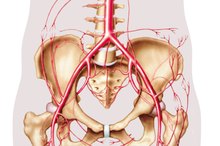What does fact checked mean?
At Healthfully, we strive to deliver objective content that is accurate and up-to-date. Our team periodically reviews articles in order to ensure content quality. The sources cited below consist of evidence from peer-reviewed journals, prominent medical organizations, academic associations, and government data.
The information contained on this site is for informational purposes only, and should not be used as a substitute for the advice of a professional health care provider. Please check with the appropriate physician regarding health questions and concerns. Although we strive to deliver accurate and up-to-date information, no guarantee to that effect is made.
What Are the Signs and Symptoms of a Stomach Aneurysm?
An aneurysm occurs when a weak area of a blood vessel’s wall bulges, sort of like a balloon. As the aneurysm gets bigger, the arterial wall gets thinner. If the wall becomes too thin, the aneurysm may leak or even burst, at which point the aneurysm becomes life threatening.
If you are experiencing serious medical symptoms, seek emergency treatment immediately.
Most aneurysms affect the aorta, which carries the blood from your heart to the rest of your body. Aortic aneurysms may occur in the chest, called a thoracic aneurysm, or below the stomach, called an abdominal or stomach aneurysm 2. The abdominal aorta is responsible for supplying blood to the lower half of the body.
The Mayo Clinic reports that about 75 percent of aortic aneurysms are abdominal.
According to Omni Medical Search, in the United States ruptured aneurysm of the aorta is 10th on the list of causes of death in men over 50. Despite these seemingly bleak numbers, aortic aneurysms can be effectively treated and even cured if they’re caught early.
Causes
The exact cause of abdominal aortic aneurysms, or AAA, is not known, but it is the general consensus that inflammation of the aorta causes the arterial wall to become thin and weak. For this reason, any condition that damages or weakens arterial walls can lead to an aneurysm. Atherosclerosis is the most common of these conditions.
Often called hardening of the arteries, atherosclerosis occurs when plaque (fatty deposits) builds up on the inner surface of the artery. As the layer of plaque thickens, the artery becomes stiff and narrow.
- The exact cause of abdominal aortic aneurysms, or AAA, is not known, but it is the general consensus that inflammation of the aorta causes the arterial wall to become thin and weak.
Symptoms of an Unruptured Abdominal Aortic Aneurysm
Neck Aneurysm Symptoms
Learn More
Abdominal aortic aneurysms are slow-growing and often do not cause symptoms, making them difficult to notice. Many never get big enough to have any effect. However, some expand more quickly, increasing the risk of rupture. Because a ruptured aneurysm puts your life in jeopardy, it is best to monitor any aneurysm that has been detected carefully for growth.
If you do have symptoms before the aneurysm ruptures, they may include tenderness and pain in the area just below your navel. You may feel a pulsing as well, like a heartbeat in your abdomen.
Experiencing sudden or severe pain in your lower back may also be a sign of abdominal aneurysm. Loss of appetite or upset stomach sometimes accompanies these symptoms.
- Abdominal aortic aneurysms are slow-growing and often do not cause symptoms, making them difficult to notice.
- If you do have symptoms before the aneurysm ruptures, they may include tenderness and pain in the area just below your navel.
Signs an Abdominal Aortic Aneurysm Has Burst
There are two major complications of abdominal aneurysm: rupture and dissection of the aorta. The first, whose incidence increases with the size of the aneurysm, refers to a breakage of the arterial wall resulting from pressure on the weak area. Dissection occurs when the layers of the arterial wall are torn. Blood then flows between the layers, forcing them apart.
This inhibits regular blood flow and may cause the aortic wall to burst. If your aortic wall bursts or breaks, you may suddenly feel extremely weak and dizzy, and possibly even lose consciousness.
Along with this comes intense and persistent abdominal pain that may radiate to your lower back or legs. Other symptoms include shortness of breath, sweatiness, rapid pulse and low blood pressure.
- There are two major complications of abdominal aneurysm: rupture and dissection of the aorta.
- This inhibits regular blood flow and may cause the aortic wall to burst.
Screening
Ripping Abdominal Pain
Learn More
**If you experience symptoms of an abdominal aneurysm, you should consult your doctor immediately for testing and diagnosis.
** Because your aneurysm may not show any symptoms, though, anyone over 60 who is at particular risk for developing an aortic aneurysm should discuss regular screening with a doctor 2. Men who smoke and are between the ages of 60 and 75 should be screened for abdominal aneurysm, as should anyone with a family history of this condition.
Risk Factors
An AAA may not provide any obvious clues until it is too late. For this reason, it is important to understand whether you are at high risk for this type of aneurysm. Males develop aneurysms far more frequently than females, but in women they are more likely to rupture. Your chances of developing abdominal aneurysm grow as you get older, with the majority of these aneurysms occurring in people over 60 years old. If you have immediate relatives who have had an AAA, you are more likely to get one, and possibly at a younger age than is usual. In the same vein, inherited diseases such as Marfan syndrome may lead to aneurysm.
Race can be a clue, as aortic aneurysms occur most frequently in white people. Consistently high blood pressure, smoking or chewing tobacco, aortic infections and deep wounds can increase your risk of developing AAA.
- An AAA may not provide any obvious clues until it is too late.
- Race can be a clue, as aortic aneurysms occur most frequently in white people.
Related Articles
References
- OmniMedicalSearch: Aneurysm
- MayoClinic: Aortic aneurysm
- Aortic Aneurysm Fact Sheet|Data & Statistics|DHDSP|CDC. Centers for Disease Control and Prevention. Jun 16, 2016.
- Abdominal aortic aneurysm: MedlinePlus Medical Encyclopedia. MedlinePlus. Oct 2, 2019.
- Aggarwal S, Qamar A, Sharma V, Sharma A. Abdominal aortic aneurysm: A comprehensive review. Exp Clin Cardiol. 2011;16(1):11-5.
- Aune D, Schlesinger S, Norat T, Riboli E. Tobacco smoking and the risk of abdominal aortic aneurysm: a systematic review and meta-analysis of prospective studies. Sci Rep. 2018;8(1):14786. doi:10.1038/s41598-018-32100-2
- Mathur A, Mohan V, Ameta D, Gaurav B, Haranahalli P. Aortic aneurysm. J Transl Int Med. 2016;4(1):35-41. doi:10.1515/jtim-2016-0008
- Final Update Summary: Abdominal Aortic Aneurysm: Screening - US Preventive Services Task Force. Final Update Summary: Abdominal Aortic Aneurysm: Screening - US Preventive Services Task Force. Jun 2014.
- Curtis W, Yano M. Acute non-traumatic disease of the abdominal aorta. Abdom Radiol (NY). 2018 May;43(5):1067-1083. doi: 10.1007/s00261-018-1525-0.
- Cury M, Zeidan F, Lobato AC. Aortic disease in the young: genetic aneurysm syndromes, connective tissue disorders, and familial aortic aneurysms and dissections. Int J Vasc Med. 2013;2013:267215. doi: 10.1155/2013/267215. Epub 2013 Jan 14.
- Ullery BW, Hallett RL Fleischmann D. Epidemiology and contemporary management of abdominal aortic aneurysms. Abdom Radiol (NY). 2018 May;43(5):1032-1043. doi: 10.1007/s00261-017-1450-7.
Writer Bio
An American living in Prague, Whitney Arana holds a Bachelor of Arts in English language and literature from Davidson College. Currently, she works as a teacher of advanced business and exam-prep English plus conversational Spanish. She contributes regularly to both Czech and American publications on topics including health, literature, food, and travel.








